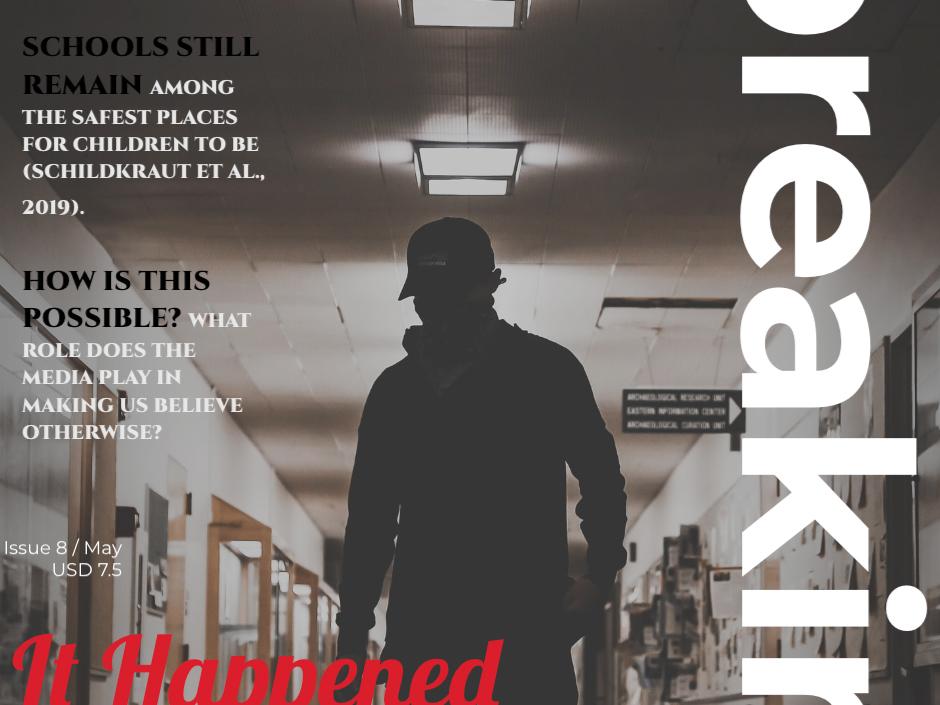Creative storytelling -- Junior criminal justice major Allyson Florczykowski created a zine for the topic of “Safety in Schools Regarding School Shootings," one of a number of creative approaches for a class taught by Jaclyn Schildkraut that offered a "choose your own adventure" approach to research projects.
The shift from face-to-face to virtual learning in the spring semester often forced faculty members to adapt and get creative with their students’ big projects.
One example was CRJ 312: “Study of Homicide and Lethal Violence,” where criminal justice faculty member Jaclyn Schildkraut was “extremely impressed” by the results of a “choose your own adventure” approach for some serious research topics.
The course studies types of murder ranging from cult killings to terrorism to mass shootings. The research paper represents a significant part of the course, and Schildkraut saw a similar idea on Twitter that “seemed like a really interesting adaptation from the traditional course paper,” she said.
“Students still have to choose a topic of interest and do in-depth research about that topic (can be a person or an event), but they get to be more creative in terms of how they present the material they learn,” Schildkraut explained. “While some still chose to write papers, others presented their research in the form of zines (online magazines), websites, multimedia PowerPoints and even podcasts!”
Senior criminal justice major Devereaux Johansen built a website on the Peoples Temple killings, also known as the 1978 Jonestown Massacre.
“I was interested in the fact that this was unlike most cult behaviors,” Johansen said. “This event in history killed a record-breaking amount of people and at their own will by the hand of their other family members. This cult killed a diverse group of people.”
In allowing more creativity and the option to learn new skills, the assignment was a “brilliant” effort by Schildkraut, Johansen said.
“I learned that college assignments can be more freedom focused but help produce incredible work,” Johansen said. “I know that my fellow classmates did a great job on this assignment.”
Visual exploration
Junior criminal justice major Allyson Florczykowski created a zine on “Safety in Schools Regarding School Shootings," focusing “on how safety has improved following the 1999 shooting at Columbine High School, as well as what more still needs to be done to improve school safety,” she said.
“It highlights the four, arguably, most infamous school shootings (Columbine, Virginia Tech, Sandy Hook and Parkland) and what went right or wrong in the events that unfolded during those shootings,” Florczykowski said. “It then goes on to discuss some important safety measures that have been put in place at varying schools and universities throughout the country in an attempt to be able to avoid the next tragic event.”
It was a topic Florczykowski was already interested in, as a research assistant with Schildkraut teaching the Standard Response Protocol to children in schools, and this allowed her to infuse knowledge and observations while exploring how to make data and research visually compelling.
“As opposed to simply writing a ten-page research paper, this project allowed me to be creative about how I presented the information, to choose what areas I wanted to highlight especially, and to make it into a professional research project that has since been appreciated by other researchers and shooting survivors,” Florczykowski said.
Senior criminal justice major Angelica Delgado also chose a zine format, focusing on cult leader Charles Manson. “I thought a magazine would be an interesting way to put my thoughts and findings together in an organized fashion,” she said.
“In my project I focused primarily on how Charles Manson became the Charles Manson that we know today,” Delgado said. “I focused a lot on his formative years and his first time in prison and how these periods of time made him the manipulator that he was.”
Delgado said she learned “quite a bit” through the opportunity to combine research, knowledge and creativity.
“I definitely learned how to be more creative as far as layouts go,” she said. “I wanted the layout to look nice, but I also wanted to be able to get as much information as possible in the project. I learned a lot about picking and choosing which information was important to my point while also trying to be sensitive to a topic that is hard for some people to talk/learn about.”
“I was extremely impressed with all of the students,” Schildkraut said. “They really went above and beyond! I didn't have much in the way of expectations as this was my first time doing the project, but I was blown away by them!”




